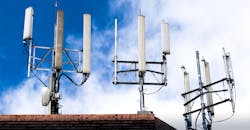Antenna arrays can provide controlled, focused signals for communications systems over wide ranges of frequencies. However, researchers at Notre Dame University-Louaize (Zouk Mosbeh, Lenanon), the American University of Beirut (Beirut, Lebanon), and the University of New Mexico (Albuquerque, N.M.) report that such arrays can also provide the dual functionality of energy harvesting when they are integrated vertically on top of a solar panel.
The dual-function design is actually two antenna arrays operating at 1.8 to 2.4 GHz. The elements of the two antenna arrays consist of copper-based and transparent inverted-F antennas. The transparent array, which has the same dimensions as the copper array, is used to verify that the integration of the copper-based antenna array does not degrade the conversion efficiency of the solar panel.
The antenna arrays cover a bandwidth with a large number of commercial wireless signals for energy harvesting. The integrated solar panel enhances the radiation characteristics of the arrays by acting as an extended ground plane.
As part of the design, an RF rectifying circuit rectifies the captured RF signals from the antenna arrays into dc power that can be combined with the output power from the solar panels and supplement the solar energy during times of low sunlight. As the ground plane increases, the antenna gain increases until achieving maximum gain of 4.6 dB for a width of 5 cm. When the width is greater than 5 cm, the gain no longer increases, but the antenna back lobe is noticeably reduced.
The RF rectifying circuit achieves high efficiency at measured frequencies of 1.5, 2.0, and 2.4 GHz; efficiency decreases with increasing frequency. The efficiency of the copper-based array is about 15% higher than that of the transparent array, likely due to the lower conductivity of the polymer used inside of the transparent material compared to the copper-based antenna elements.
During measurements of harvested voltage for the copper-based array versus the transparent array, very little difference was found between the two, even when measured every 15 minutes during a sunny day. In addition, it was found that placement of the copper antenna elements in an orthogonal fashion at both edges of the solar panel had minimal effect on the solar-energy efficiency.
The experiments showed the practical benefits of creating an additional energy source from a structure that would also be required for wireless communications. The high efficiency of the rectifying circuit is an important contribution to the overall achievement. Furthermore, by using an impedance-matching network, the same rectifying circuit can be employed for both the copper-based and the transparent antenna arrays.
See “A Communicating Antenna Array with a Dual-Energy Harvesting Functionality,” IEEE Antennas & Propagation Magazine, Vol. 60, No. 2, April 2018, p. 132.
About the Author
Jack Browne
Technical Contributor
Jack Browne, Technical Contributor, has worked in technical publishing for over 30 years. He managed the content and production of three technical journals while at the American Institute of Physics, including Medical Physics and the Journal of Vacuum Science & Technology. He has been a Publisher and Editor for Penton Media, started the firm’s Wireless Symposium & Exhibition trade show in 1993, and currently serves as Technical Contributor for that company's Microwaves & RF magazine. Browne, who holds a BS in Mathematics from City College of New York and BA degrees in English and Philosophy from Fordham University, is a member of the IEEE.

